1. Introduction to Lines and Angles
- Books Name
- CBSE Class 7 Mathematics Book
- Publication
- Param Publication
- Course
- CBSE Class 7
- Subject
- Mathmatics
INTRODUCTION
1. Point:
A fine dot made by a sharp pencil or a geometrical figure having no length, breadth and height as called a point.
2. Line segment
If we join two fixed points then the figure formed is called line segment.
3. Line
If we extend the two end points of a line segment in either direction endlessly then it is called a line.
It has no definite length.
4. Ray
If we extend one end point of a line segment endlessly then it is called a ray.


5. Angle
An angle is formed by intersecting two rays. The intersection point is the common initial point of these two rays which is called as vertex of the angle. We use the symbol ‘ ∠’ to denote the measure of the angle
• An angle is an inclination between two rays with the same initial point.
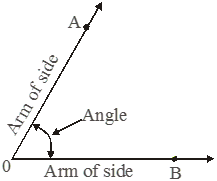
In this fig. the angles are ∠∠
°°
°
°
°
°°
2. Angles on a straight line, intersecting lines
- Books Name
- CBSE Class 7 Mathematics Book
- Publication
- Param Publication
- Course
- CBSE Class 7
- Subject
- Mathmatics
OTHER TYPES OF ANGLES
1. Complementary angles: If the sum of the measures of two angles is 90° then the angles are complementary angles and each angle is complement of the other angle.
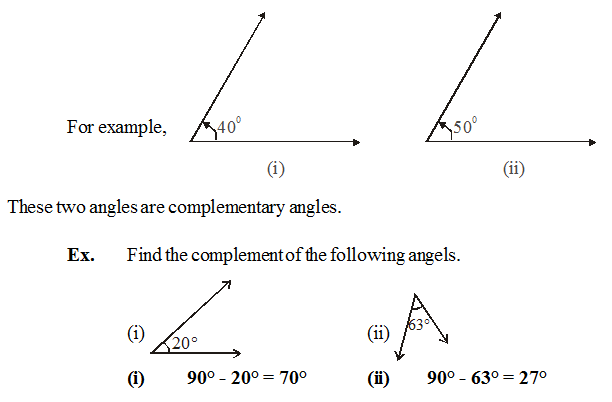
2. Supplementary angles: If the sum of the measures of two angles is 1800 then the angles are called supplementary angles and each angle is said to be the supplement of the other.
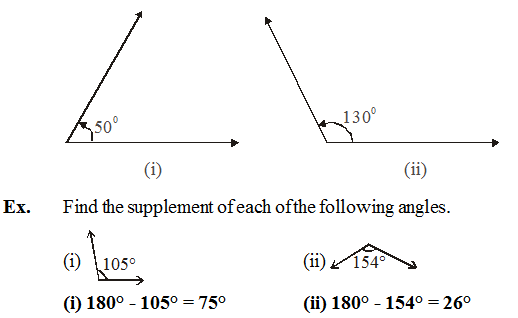
Illustration 1
Find the measure of an angle which is complement of itself.
Solution
Let the measure of the angle be xº. Then, the measure of its complement is given to be xº.
Since, the sum of the measures of an angle and its complement is 90º.
∴ xº + xº = 90º
⇒ 2xº = 90º
⇒ xº = 45
Hence, the measure of the angle is 45º.
Illustration 2
Two supplementary angles differ by 34º. Find the angles.
Solution
Let one angle be xº. Then, the other angle is (x + 34)º.
Now, xº and (x + 34)º are supplementary angles.
∴ xº + (x + 34)º = 180º
⇒ 2xº + 34º = 180º
⇒ 2xº = 180º – 34º
⇒ 2xº = 146º
⇒ xº = 73º.
Hence, the measures of two angles are 73º and 73º + 34º = 107º.
3. Adjacent angle :
If a pair of angles have :
a. a common vertex
b. a common arm
c. and their non-common arms are on either side of the common arm. Such pairs of angles are called adjacent angles. Adjacent angles have no common interior points.
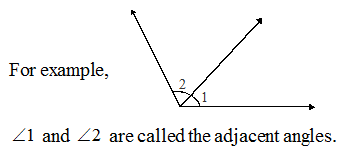
4. Linear pair: A pair of adjacent angles whose non-common sides are opposite rays. The angles in a linear pair are supplementary.
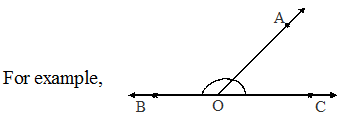
Here OA is common arm and OB and OC form opposite rays. ∠∠180°
By seeing this fig. we can say that if a ray stand on a line, then the sum of the two adjacent angles so formed is 180°.
5. Vertically opposite angles
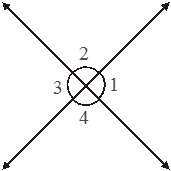

3. Transversal lines
- Books Name
- CBSE Class 7 Mathematics Book
- Publication
- Param Publication
- Course
- CBSE Class 7
- Subject
- Mathmatics
Pair of lines
1. Intersecting lines : Two lines are called intersecting lines if they have a common point. This common point is called the point of intersection.
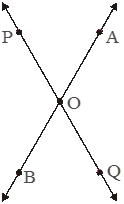
AB and PQ is called the intersecting lines and O is called a point of intersection.
2. Transversal : A line that intersects two or more lines at distinct points is called a transversal.
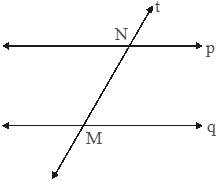
In this fig. t is the transversal which cut two lines p and q at distinct points, ‘N’ and ‘M’ respectively.
3. Perpendicular lines:
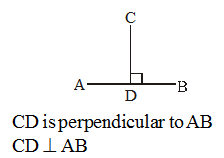
Angles made by a transversal
Two lines p and q cut by a transversal t. It form angles that have some special names as :
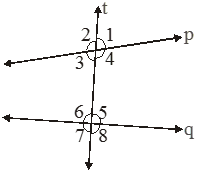
(i) Exterior angles : The angles whose arms do not contain the segment on the transversal cut by the given lines are called exterior angles. Such as ∠1, ∠2 and ∠7 and ∠8
(ii) Interior angles : The angles whose one of the arms contains the segment on the transversal cut by the given lines are called interior angles. Such as ∠3, ∠4, ∠5 and ∠6
(iii) Corresponding angles : A pair of angles in which one arm of both the angles of the pair is on the same side of the transversal and the other arms are directed in the same sense is called a pair of corresponding angles. Such as ∠1 and ∠5, ∠4 and ∠8, ∠2 and∠6 and ∠3 and ∠7 are corresponding angles.
(iv) Alternate interior angles : A pair of angles in which one arm of each of the angles is on opposite sides of the transversal and whose other arm contains the segment on the transversal cut by the given lines is called a pair of alternate interior angles.
(v) Alternate exterior angles : A pair of angles in which one arm of each of the angles is on opposite sides of the transversal and whose other arm is directed in opposite sense doesnot contains the segment on the transversal cut by the given lines is called a pair of alternate exterior angles.

Checking for Parallel Lines
- Books Name
- CBSE Class 7 Mathematics Book
- Publication
- Param Publication
- Course
- CBSE Class 7
- Subject
- Mathmatics
Transveral of parallel lines
Parallel lines are those lines on a plane that do not intersect anywhere.
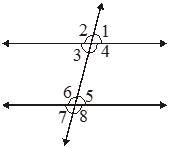
If two parallel lines are cut by a transversal, then
• Each pair of corresponding angles are equal
• Each pair of alternate interior angles are equal
• Each pair of interior angles on the same side of the transversal are supplementary.

• If two lines are cut by a transversal and it is given that the pair of corresponding angles are equal or the pair of alternate interior angles or the pair of interior angles are supplementary then the lines have to be parallel.
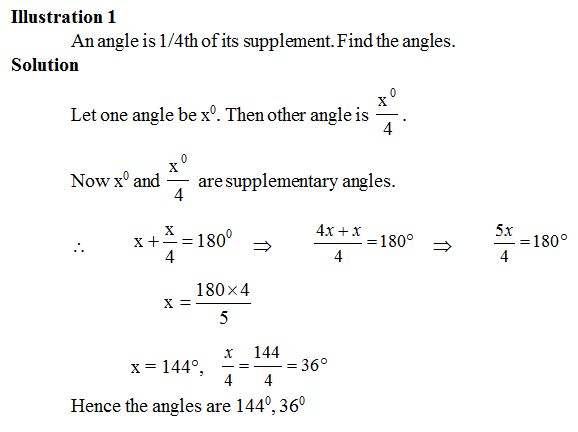
Illustration 2
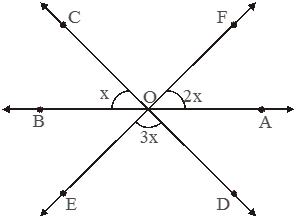
Determine the value of x
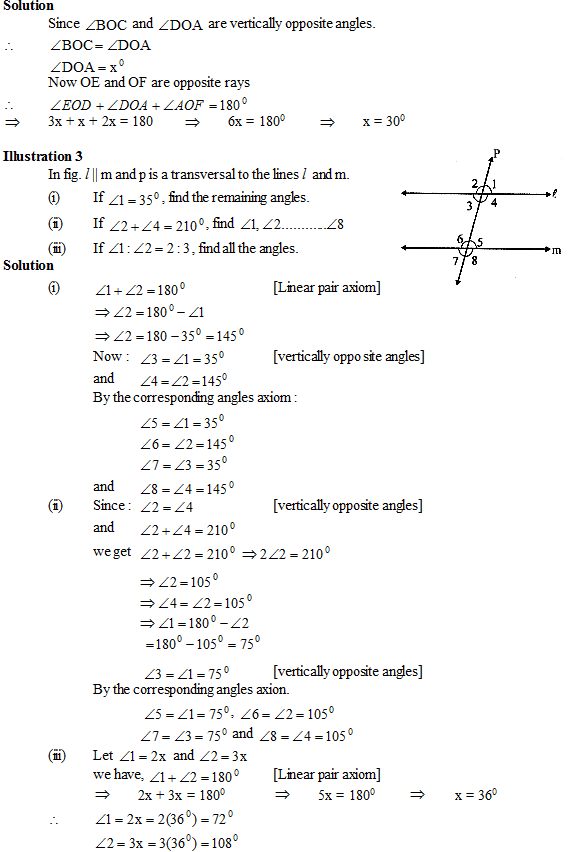
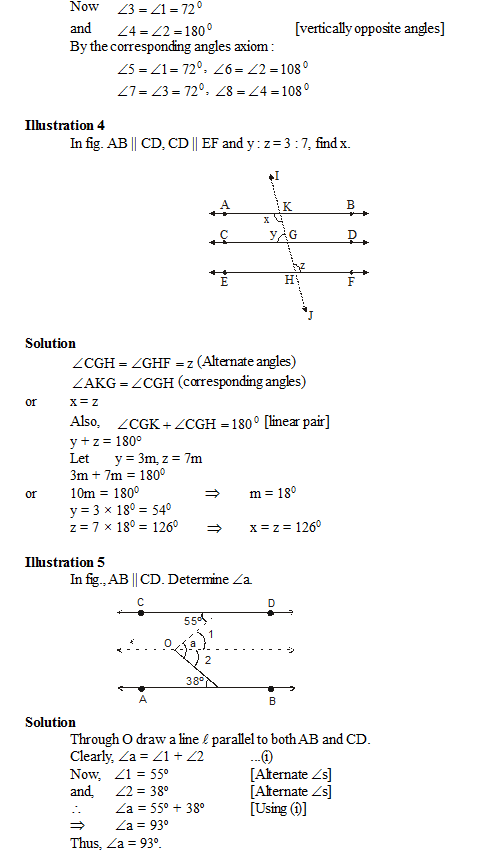

 ReginaTagebücher
ReginaTagebücher
 Param Publication
Param Publication
